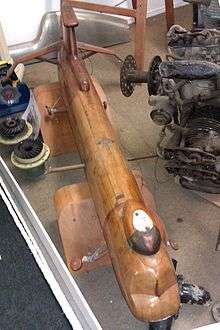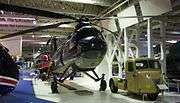Bristol Belvedere
| Type 192 Belvedere | |
|---|---|
 | |
| The Bristol Type 192 Belvedere tandem rotor helicopter. | |
| Role | Cargo helicopter |
| Manufacturer | Bristol Aeroplane Company |
| First flight | 5 July 1958 |
| Introduction | 1961 |
| Retired | 1969 |
| Primary user | Royal Air Force |
| Number built | 26 |
| Developed from | Bristol Type 173 |
The Bristol Type 192 Belvedere was a British twin-engine, tandem rotor military helicopter built by the Bristol Aeroplane Company. It was designed for a variety of transport roles including troop transport, supply dropping and casualty evacuation. It was operated by the Royal Air Force (RAF) from 1961 to 1969.
Design and development

The Belvedere was based on the Bristol Type 173 10-seat (later 16-seat) civilian helicopter which first flew on 3 January 1952. The 173 project was cancelled in 1956 and Bristol spent time on the Type 191 and Type 193 to Royal Navy and Royal Canadian Navy specifications. These two naval variants were cancelled, but the RAF expressed an interest in the aircraft and the Type 192 "Belvedere" was created. Three Type 191 airframes were almost complete when the order was cancelled, but they were used to aid the development of the Type 192. The first two were used as test rigs for the new Napier Gazelle engines and the third was used for fatigue tests.[1][2]
The Type 192 shared some of its design features with the cancelled naval variants, which made it less than ideal for transporting troops. The front undercarriage was unusually tall, originally designed to give adequate clearance for loading torpedoes underneath the fuselage in the anti-submarine warfare role. This left the main passenger and cargo door 4 feet (1.2 m) above the ground. The engines were placed at either end of the cabin. (By comparison the purpose-designed troop transport contemporary Boeing Vertol CH-46 Sea Knight had its engines above the aft cabin to permit a rear loading ramp). To provide access to the cabin from the cockpit there was a small entry past the engine that resulted in a bulge on the left side of the fuselage.[1][3]
The first Type 192 prototype XG447 flew on 5 July 1958 with tandem wooden rotor blades, a completely manual control system and a castored, fixed quadricycle undercarriage. From the fifth prototype, the rotors fitted were all-metal, four-bladed units. Production model controls and instruments allowed night operations. The prototype machines had an upwards-hinged main passenger and cockpit door, which was prone to being slammed shut by the downwash from the rotors. This was replaced by a sliding door on the later aircraft.[3]
Twenty-six Belvederes were built, entering service as the Belvedere HC Mark 1. The Belvederes were originally designed for use with the Royal Navy but were later adapted to carry 18 fully equipped troops with a total load capacity of 6,000 lb (2,700 kg). The two rotors were synchronised through a shaft to prevent blade collision, allowing the aircraft to operate through only one engine in the event of an emergency. In that case, the remaining engine would automatically run up to double power to compensate.[4]
Bristol attempted to market a civilian variant of the helicopter, designated the Type 192C. The 192C would have had seats for 24 passengers and was aimed at intercity services.[5] To demonstrate the aircraft's potential, Bristol chief test pilot Charles "Sox" Hosegood set the London–Paris and Paris–London speed records in May 1961 in a Belvedere.[6] However, no orders were placed for the 192C.[7]
Operational history
The first prototype Belvedere went to the Belvedere Trials Unit at RAF Odiham, which was subsequently reformed as No. 66 Squadron RAF in 1961. Engine starter problems caused trouble early on but operational deployment continued. The prototype saw service in Europe, Africa, Southern Arabia and Borneo. XG447 was broken up at Boscombe Down on 7 August 1966.[8]
In June 1960 the fifth prototype, XG452 set a speed record of 130 mph (210 km/h) between Gatwick and Tripoli. In 1962 a 72 Squadron Belvedere lowered the 80 ft tall spire onto the new Coventry Cathedral.[9]
As well as 66 Squadron, the type was deployed to 72 Squadron in 1961 and 26 Squadron in 1962, all at RAF Odiham. 26 Squadron later transferred to RAF Khormaksar where it disbanded in November 1965. The helicopters were transferred by HMS Albion to Singapore to join 66 Squadron until the squadron was disbanded in 1969. 72 Squadron kept its Belvederes until August 1964 when it exchanged them for Westland Wessex.[10]
The RAF Belvederes were involved in combat in Aden Emergency and Borneo (during the Indonesia–Malaysia confrontation).
Variants

- Type 173
- Civil transport prototype
- Type 191
- Projected naval version. Never flown; first two aircraft used as Gazelle ground test rigs for Type 192.[11]
- Type 192
- Military transport helicopter for the Royal Air Force, under designation Belvedere HC Mk 1.
- Type 192C
- Proposed civil version with 24 seats, not built.[5]
- Type 193
- Variant for the Royal Canadian Navy based on the Type 191, not built.
Operators
Aircraft on display


The following Bristol Belvederes have been preserved and are either on display or currently undergoing restoration.
Belvedere HC.1
- XG452 undergoing restoration at The Helicopter Museum, Weston-Super-Mare.
- XG454 on display at Museum of Science and Industry in Manchester
- XG474 on display at Royal Air Force Museum, Hendon
- XG462 (Nose section only) The Helicopter Museum, Weston-Super-Mare
Specifications (Belvedere HC.1)
Data from Flight 1962[13]
General characteristics
- Crew: 3
- Capacity:
- 19 fully equipped troops or
- 12 stretchers with two seated wounded and a medical attendant[14]
- Payload: 6,000 lb (2,700 kg) internal or slung
- Length: 54 ft 4 in (16.56 m)
- Rotor diameter: 48 ft 11 in (14.9 m)
- Height: 17 ft 0 in[14] (5.18 m)
- Disc area: 3,270 sq ft (303.9 m²)
- Empty weight: 11,350 lb (5,159 kg)
- Max. takeoff weight: 19,000 lb (8,600 kg)
- Powerplant: 2 × Napier Gazelle turboshaft, 1,465 hp (1,092 kW) each
- Fuel capacity: 560 imp gal
Performance
- Cruise speed: 138 mph (120 knots, 222 km/h) maximum
- Range: 460 mi (400 nmi, 720 km) standard tankage
- Service ceiling: 12,000 ft (3,660 m)
- Rate of climb: 850 ft/min (4.3 m/s)
- Vertical climb rate: 440 ft/min
See also
- Related development
- Aircraft of comparable role, configuration and era
- Related lists
References
- Notes
- 1 2 "Bristol 192, Europe's Largest Military Helicopter". Flight International. 74 (2584): 170–172. 1 August 1958. Retrieved 13 September 2011.
- ↑ "Bristol Type 191 Production List". Filton Flyer. Retrieved 16 September 2011.
- 1 2 "In the Air: Westland Belvedere". Flight International. 81 (2761): 211–214. 8 February 1962. Retrieved 2011-09-16.
- ↑ Flight International, 8 February 1962 p212
- 1 2 "Brevities". Flight International. 76 (2631): 29. 14 August 1959. Retrieved 16 September 2011.
- ↑ "Bristow Spirit sets London–Paris records". Flight International: 134. 19 January 1980. Retrieved 16 September 2011.
- ↑ "Bristol Belvedere". Tangmere Military Aviation Museum. Retrieved 5 November 2015.
- ↑ "Bristol Belvedere c/n 13342 1958 to 1966". Helis.com. Retrieved 5 November 2015.
- ↑ "Operation Fleche (photo caption)". Flight International: 679. 3 May 1962.
- ↑ Jefford, RAF Squadrons
- ↑ Barnes 1970, pp.368–9
- 1 2 3 Lambert, Mark (8 February 1962). "Westland Belvedere". Flight International. via Flightglobal: 211. Retrieved 18 October 2014.
- ↑ Lambert 1962, p. 155.
- 1 2 Taylor 1961, pp. 190–191.
- Bibliography
- Barnes, C.H., Bristol Aircraft since 1910.London: Putnam Publishing, 1970. ISBN 0-370-00015-3
- Jefford, C.G., RAF Squadrons. Shrewsbury: Airlife Publishing, 2nd edition, 2001. ISBN 1-84037-141-2
- Lambert, Mark. "In The Air: No 155 : Westland Belvedere". Flight International, 8 February 1962, pp. 211–214.
- Taylor, John W. R. Jane's All The World's Aircraft 1961–62. London: Sampson Low, Marston & Company, 1961.
External links
| Wikimedia Commons has media related to Bristol Type 192 Belvedere. |
- Bristol Belvedere helis.com helicopter database
- Video of helicopter operations in the Far East, including shots of a flypast of 11 Belvederes